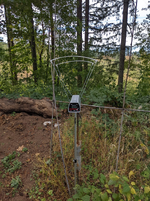Silver Lifetime
- Messages
- 43,065
- Reactions
- 111,977
I have more than once shot these loads back to back and claimed that the velocity was about the same, but that I could shoot the .40 faster than the .45 due to the greater perceived recoil of the .45 vs. the .40
Note that the 226 and the 227 are almost the same gun, except for the caliber.
Rem 180gr FMJ .40 - SIG 224 3.5" barrel - 927 fps
Rem 180gr FMJ .40 - SIG 226 4.4" barrel - 948 fps
Rem Golden Saber 185gr JHP - SIG 227 4.4" barrel .45 ACP - 912 fps
My hi-tech ballistics lab:

Note that the 226 and the 227 are almost the same gun, except for the caliber.
Rem 180gr FMJ .40 - SIG 224 3.5" barrel - 927 fps
Rem 180gr FMJ .40 - SIG 226 4.4" barrel - 948 fps
Rem Golden Saber 185gr JHP - SIG 227 4.4" barrel .45 ACP - 912 fps
My hi-tech ballistics lab:












